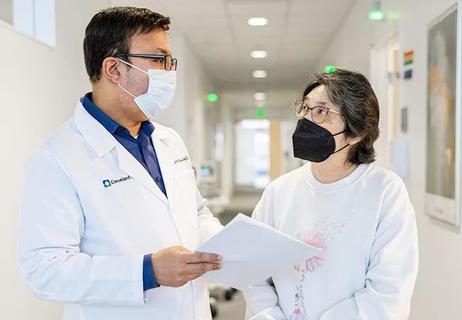On March 1, 2020, Cleveland Clinic Cancer Center research program manager Kim Jenkins, MSNM, received approval for 17 research coordinators to work from home one day a week. This was part of a remote pilot work project. However, three weeks later, because of the global pandemic, the entire team of 60 research coordinators was sent home to work. Because the research team developed a productivity tracker, Ms. Jenkins has been able to record the time it takes them to complete data entry and measure the team’s productivity. The data has proven that research coordinators are actually more productive when working from home.
Cleveland Clinic is a non-profit academic medical center. Advertising on our site helps support our mission. We do not endorse non-Cleveland Clinic products or services. Policy
The cancer research team has traditionally been based in a non-patient facing office setting. They are responsible for the regulatory and data entry aspects of nearly 400 clinical trials and 2,000 research patients across the research oncology department.
Between March 1 and June 29, 2,369 observations were tracked and analyzed. It takes a coordinator roughly three hours to enter data, so Ms. Jenkins calculated that her team entered significantly more data fields at home per day compared with the office.
“I think traditional, academic medical centers have been averse to allowing their clinical research teams to work from home,” Ms. Jenkins says. However, she states that major pharmaceutical companies have been taking advantage of home-based teams for decades. The same is true for companies in the tech, health insurance, customer service and sales sectors. “I believe my research has the potential to help increase confidence that teams remain productive when working from home. Employees do not have to be in direct view of upper-level management in order to remain highly productive at home.”
Ms. Jenkins has also noticed an uptick in her team’s morale.
“Almost every team member has taken the time to reach out and express gratitude that they’re able to work from home,” she says. “During the COVID-19 pandemic, they feel safer and more comfortable. And, there are fewer stressors related to a commute and fuel and parking costs.”
The ability to work from home might also help during the hiring process and with retaining employees.
“People with long commutes are much more likely to consider taking a job knowing there is flexibility to work from home,” says Nate Pennell, MD, PhD, Vice Chair for Clinical Research. “Throughout the last few months, we’ve seen incredibly low turnover rates. I think that trend will continue into the future. Because of the opportunity to work from home, we’ll be able to continue retaining employees.”
Prior to working from home, the research team developed a productivity tracker with help from a commercial software system. A secure web application used for building and managing online databases, the system can be used to collect any type of data in any environment. It’s specifically geared to support online and offline capture for research studies and operations.
Ms. Jenkins explains that there’s very little hard data or evidence on how working from home, versus in the office, affects productivity. However, her team seen an uptick in productivity of 17%. That data, she says, is tracked in the system.
She says, “The time it takes my team to open trials has dramatically reduced since Q3 of 2019. The number of trials we are able to open each quarter has nearly doubled since 2019. While there were other important factors that contributed to these successes, I firmly believe that my team’s increased productivity helped buoy these successes.”
Ms. Jenkins presented her data at the virtual 62nd ASH Annual Meeting and Exposition on December 7. By sharing her research, she hopes other academic centers will consider allowing their non-patient facing teams to also work from home.

First-of-its-kind research investigates the viability of standard screening to reduce the burden of late-stage cancer diagnoses

Study demonstrates ability to reduce patients’ reliance on phlebotomies to stabilize hematocrit levels

Findings highlight an association between obesity and an increased incidence of moderate-severe disease

Cleveland Clinic Cancer Institute takes multi-faceted approach to increasing clinical trial access

Key learnings from DESTINY trials

Gene editing technology offers promise for treating multiple myeloma and other hematologic malignancies, as well as solid tumors

Study of 401,576 patients reveals differences in cancer burdens as well as overall survival

Enfortumab plus pembrolizumab reduced risk of death by 53% compared with platinum-based chemotherapy